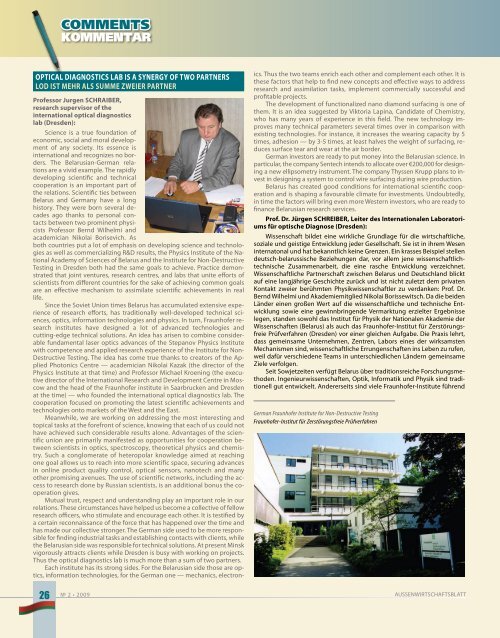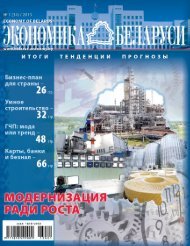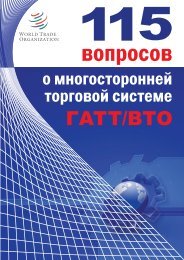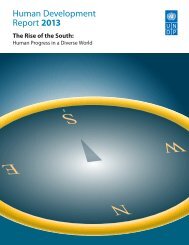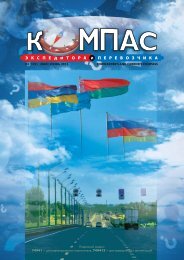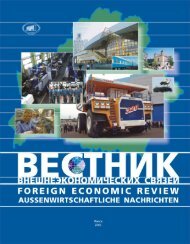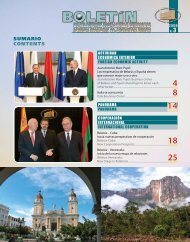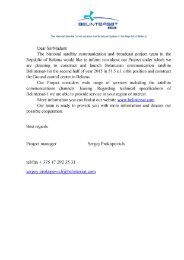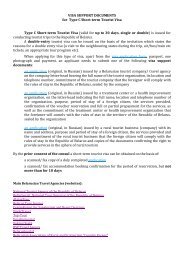BELARus
BELARus
BELARus
Erfolgreiche ePaper selbst erstellen
Machen Sie aus Ihren PDF Publikationen ein blätterbares Flipbook mit unserer einzigartigen Google optimierten e-Paper Software.
opTiCAL DiAGnosTiCs LAB is A synERGy oF Two pARTnERs<br />
LoD isT mEHR ALs summE ZwEiER pARTnER<br />
professor jurgen sCHRAiBER,<br />
research supervisor of the<br />
international optical diagnostics<br />
lab (Dresden):<br />
Science is a true foundation of<br />
economic, social and moral development<br />
of any society. Its essence is<br />
international and recognizes no borders.<br />
The Belarusian-German relations<br />
are a vivid example. The rapidly<br />
developing scientific and technical<br />
cooperation is an important part of<br />
the relations. Scientific ties between<br />
Belarus and Germany have a long<br />
history. They were born several decades<br />
ago thanks to personal contacts<br />
between two prominent physicists<br />
Professor Bernd Wilhelmi and<br />
academician Nikolai Borisevich. As<br />
both countries put a lot of emphasis on developing science and technologies<br />
as well as commercializing R&D results, the Physics Institute of the National<br />
Academy of Sciences of Belarus and the Institute for Non-Destructive<br />
Testing in Dresden both had the same goals to achieve. Practice demonstrated<br />
that joint ventures, research centres, and labs that unite efforts of<br />
scientists from different countries for the sake of achieving common goals<br />
are an effective mechanism to assimilate scientific achievements in real<br />
life.<br />
Since the Soviet Union times Belarus has accumulated extensive experience<br />
of research efforts, has traditionally well-developed technical sciences,<br />
optics, information technologies and physics. In turn, Fraunhofer research<br />
institutes have designed a lot of advanced technologies and<br />
cutting-edge technical solutions. An idea has arisen to combine considerable<br />
fundamental laser optics advances of the Stepanov Physics Institute<br />
with competence and applied research experience of the Institute for Non-<br />
Destructive Testing. The idea has come true thanks to creators of the Applied<br />
Photonics Centre — academician Nikolai Kazak (the director of the<br />
Physics Institute at that time) and Professor Michael Kroening (the executive<br />
director of the International Research and Development Centre in Moscow<br />
and the head of the Fraunhofer institute in Saarbrucken and Dresden<br />
at the time) — who founded the international optical diagnostics lab. The<br />
cooperation focused on promoting the latest scientific achievements and<br />
technologies onto markets of the West and the East.<br />
Meanwhile, we are working on addressing the most interesting and<br />
topical tasks at the forefront of science, knowing that each of us could not<br />
have achieved such considerable results alone. Advantages of the scientific<br />
union are primarily manifested as opportunities for cooperation between<br />
scientists in optics, spectroscopy, theoretical physics and chemistry.<br />
Such a conglomerate of heteropolar knowledge aimed at reaching<br />
one goal allows us to reach into more scientific space, securing advances<br />
in online product quality control, optical sensors, nanotech and many<br />
other promising avenues. The use of scientific networks, including the access<br />
to research done by Russian scientists, is an additional bonus the cooperation<br />
gives.<br />
Mutual trust, respect and understanding play an important role in our<br />
relations. These circumstances have helped us become a collective of fellow<br />
research officers, who stimulate and encourage each other. It is testified by<br />
a certain reconnaissance of the force that has happened over the time and<br />
has made our collective stronger. The German side used to be more responsible<br />
for finding industrial tasks and establishing contacts with clients, while<br />
the Belarusian side was responsible for technical solutions. At present Minsk<br />
vigorously attracts clients while Dresden is busy with working on projects.<br />
Thus the optical diagnostics lab is much more than a sum of two partners.<br />
Each institute has its strong sides. For the Belarusian side those are optics,<br />
information technologies, for the German one — mechanics, electron-<br />
26<br />
cOmmENTS<br />
KOmmENTar<br />
ics. Thus the two teams enrich each other and complement each other. It is<br />
these factors that help to find new concepts and effective ways to address<br />
research and assimilation tasks, implement commercially successful and<br />
profitable projects.<br />
The development of functionalized nano diamond surfacing is one of<br />
them. It is an idea suggested by Viktoria Lapina, Candidate of Chemistry,<br />
who has many years of experience in this field. The new technology improves<br />
many technical parameters several times over in comparison with<br />
existing technologies. For instance, it increases the wearing capacity by 5<br />
times, adhesion — by 3-5 times, at least halves the weight of surfacing, reduces<br />
surface tear and wear at the air border.<br />
German investors are ready to put money into the Belarusian science. In<br />
particular, the company Sentech intends to allocate over €200,000 for designing<br />
a new ellipsometry instrument. The company Thyssen Krupp plans to invest<br />
in designing a system to control wire surfacing during wire production.<br />
Belarus has created good conditions for international scientific cooperation<br />
and is shaping a favourable climate for investments. Undoubtedly,<br />
in time the factors will bring even more Western investors, who are ready to<br />
finance Belarusian research services.<br />
prof. Dr. jürgen sCHREiBER, Leiter des internationalen Laboratoriums<br />
für optische Diagnose (Dresden):<br />
Wissenschaft bildet eine wirkliche Grundlage für die wirtschaftliche,<br />
soziale und geistige Entwicklung jeder Gesellschaft. Sie ist in ihrem Wesen<br />
internatonal und hat bekanntlich keine Grenzen. Ein krasses Beispiel stellen<br />
deutsch-belarussische Beziehungen dar, vor allem jene wissenschaftlichtechnische<br />
Zusammenarbeit, die eine rasche Entwicklung verzeichnet.<br />
Wissenschaftliche Partnerschaft zwischen Belarus und Deutschland blickt<br />
auf eine langjährige Geschichte zurück und ist nicht zuletzt dem privaten<br />
Kontakt zweier berühmten Physikwissenschaftler zu verdanken: Prof. Dr.<br />
Bernd Wilhelmi und Akademiemitglied Nikolai Borissewitsch. Da die beiden<br />
Länder einen großen Wert auf die wissenschaftliche und technische Entwicklung<br />
sowie eine gewinnbringende Vermarktung erzielter Ergebnisse<br />
legen, standen sowohl das Institut für Physik der Nationalen Akademie der<br />
Wissenschaften (Belarus) als auch das Fraunhofer-Institut für Zerstörungsfreie<br />
Prüfverfahren (Dresden) vor einer gleichen Aufgabe. Die Praxis lehrt,<br />
dass gemeinsame Unternehmen, Zentren, Labors eines der wirksamsten<br />
Mechanismen sind, wissenschaftliche Errungenschaften ins Leben zu rufen,<br />
weil dafür verschiedene Teams in unterschiedlichen Ländern gemeinsame<br />
Ziele verfolgen.<br />
Seit Sowjetzeiten verfügt Belarus über traditionsreiche Forschungsmethoden.<br />
Ingenieurwissenschaften, Optik, Informatik und Physik sind traditionell<br />
gut entwickelt. Andererseits sind viele Fraunhofer-Institute führend<br />
German Fraunhofer Institute for Non-Destructive Testing<br />
Fraunhofer-Institut für Zerstörungsfreie Prüfverfahren<br />
№ 2 • 2009 AUSSENWIRTSCHAFTSBLATT


